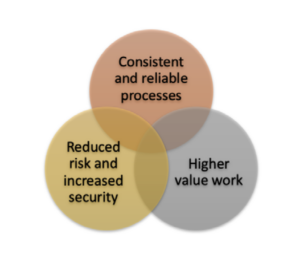
M&E Journal: The Value in Automating the Future
For any business to thrive, change must happen. Companies must adapt to a wide range of factors, but it primarily revolves around the processes of how it gets work done.
Everyone in the working world is familiar with automation, but most of us relate to it as something that replaces manual work with computers or new equipment with the ultimate goal of cutting costs.
With the proliferation of cloud-based service offerings and a multitude of technological advancements in the content processing space, automation is quickly becoming a priority for businesses in the entertainment industry with implementation justifications exceeding beyond cost efficiency.
 Successful automation initiatives have mostly been welcomed by companies to boost profits at the expense of employees whose roles have been eliminated.
Successful automation initiatives have mostly been welcomed by companies to boost profits at the expense of employees whose roles have been eliminated.
This is usually the case for automation projects where the scope of planning is not expanded enough to cover the entire business operations within the company, or if there are employees who refuse to broaden their skills become involved.
However, a win-win situation for employers and employees can be achieved with a comprehensive planning strategy coupled with proactive involvement in implementing specific automation process changes.
As with any organizational change, disruption is expected.
Upper management will usually be motivated by the promised results, while rank and file employees will usually be disappointed with routine changes, or worse, the elimination of their positions.
A competitive company’s workforce should be primed and retrained to keep up with the evolution of internal workflows.
Although management and employees who refuse to adapt to change are a lost cause, we intend to consider the value of automation in this article along with the goal of enlightening readers to the fact that process automation will be a large part of any successful company’s initiative for long-term survival.
Automation has immediate benefits upon implementation.
Faster job completion will be apparent arising from the reduction or even the elimination of manual job intervention.
Multiple tasks performed with a computer will be completed faster if separate tasks are connected through automation without the limitations from the involvement of an employed human operator.
Quicker job turnaround will naturally result in the completion of a higher volume of work.
Achieving higher capacity means a company can reach economies of scale without increasing headcount or capital expenditures.
Minimal human intervention also results in error reduction with the assumption that properly automated process exception handling and adequate instruction testing protocols are in place.
Automation will also produce inherently consistent and reliable processes.
The common tendency of computers to fail with trivial omissions or coding mis- takes will force the creation of complete and accurate automation instructions.
 This requirement also forces all workflows preceding and following the automated processes to be consistent as well as reliable.
This requirement also forces all workflows preceding and following the automated processes to be consistent as well as reliable.
Along with the elimination of repetitive manual tasks, comes the opportunity for employees to be assigned higher value and more meaningful work. This is where the continuous training of employees as well as promoting an atmosphere of learning within the workplace are crucial.
Most employees welcome the opportunity to learn in exchange for advancement. An automation initiative should include a plan to reallocate displaced resources to existing or newly created business processes.
In addition, the elimination of employees handling sensitive content significantly reduces the risk of content leaks or theft.
The additional boost in security and confidentiality from any automation initiative reduces the cost of implementing physical security measures while simultaneously taking advantage of the company’s existing cybersecurity infrastructure.
Similarly, other benefits and opportunities exist for the further development of service offerings as well as business process enhancements.
For example, the continuous availability of automated systems will allow for the creation of an on-demand self-service portal for clients.
This service offering enhancement will virtually eliminate the need to maintain a company’s hours of operations and removes the restrictions associated with working across different time zones.
The integration of various cloud and software services also presents the opportunity of leveraging additional capabilities from such services for further business process improvements or even the creation of additional service offerings.
 The current state of technologies enables access to cross platform development resources through application programming interfaces (APIs) as well as software development kits (SDKs).
The current state of technologies enables access to cross platform development resources through application programming interfaces (APIs) as well as software development kits (SDKs).
In addition to building upon core business operation processes, such development efforts can be focused on increasing business intelligence capabilities.
Similarly, relevant metrics and data can be extracted from automated business processes with the goal of interpreting the collected information to discover new service offerings as well as to further develop process improvements.
The maturity and proven capabilities of cloud-based offerings have made software as a service and all other related solutions, accessible to all service-based companies.
Like how e-commerce has permanently changed the way physical goods are sold, integrated cloud-based solutions will change the way digital content processing services are performed and delivered.
The availability of disparate service offerings with open integration capabilities is the perfect opportunity for the creation of a unified automated workflow system.
* By Eric Collins, President, CEO, and Mark Wright, Manager, Automation, LADB *
=============================================
Click here to download the complete .PDF version of this article
Click here to download the entire Winter 2022 M&E Journal
